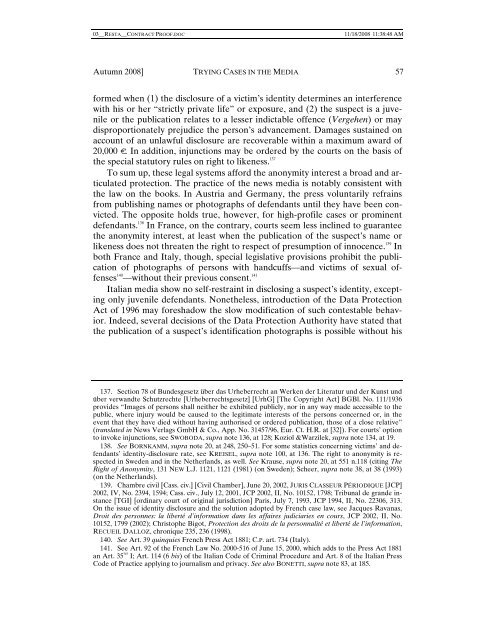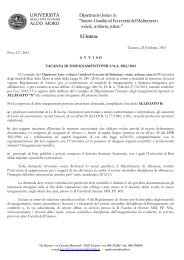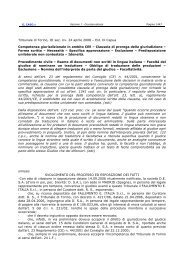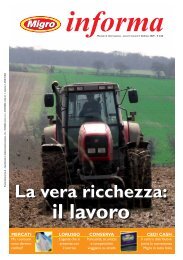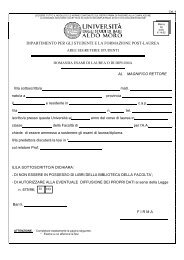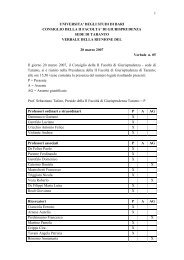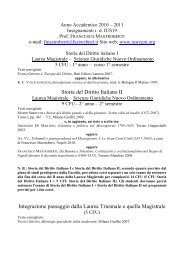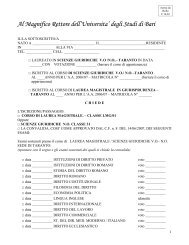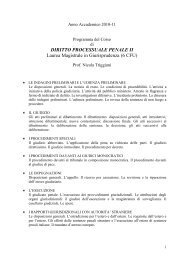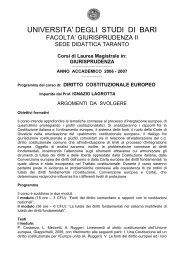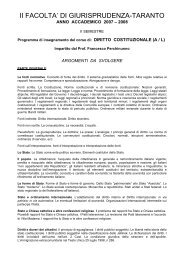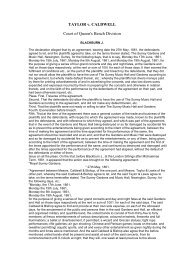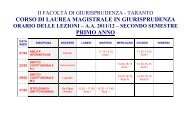TRYING CASES IN THE MEDIA: A COMPARATIVE OVERVIEW
TRYING CASES IN THE MEDIA: A COMPARATIVE OVERVIEW
TRYING CASES IN THE MEDIA: A COMPARATIVE OVERVIEW
You also want an ePaper? Increase the reach of your titles
YUMPU automatically turns print PDFs into web optimized ePapers that Google loves.
03__RESTA__CONTRACT PROOF.DOC11/18/2008 11:38:48 AMAutumn 2008] <strong>TRY<strong>IN</strong>G</strong> <strong>CASES</strong> <strong>IN</strong> <strong>THE</strong> <strong>MEDIA</strong> 57formed when (1) the disclosure of a victim’s identity determines an interferencewith his or her “strictly private life” or exposure, and (2) the suspect is a juvenileor the publication relates to a lesser indictable offence (Vergehen) or maydisproportionately prejudice the person’s advancement. Damages sustained onaccount of an unlawful disclosure are recoverable within a maximum award of20,000 €. In addition, injunctions may be ordered by the courts on the basis ofthe special statutory rules on right to likeness. 137To sum up, these legal systems afford the anonymity interest a broad and articulatedprotection. The practice of the news media is notably consistent withthe law on the books. In Austria and Germany, the press voluntarily refrainsfrom publishing names or photographs of defendants until they have been convicted.The opposite holds true, however, for high-profile cases or prominentdefendants. 138 In France, on the contrary, courts seem less inclined to guaranteethe anonymity interest, at least when the publication of the suspect’s name orlikeness does not threaten the right to respect of presumption of innocence. 139 Inboth France and Italy, though, special legislative provisions prohibit the publicationof photographs of persons with handcuffs—and victims of sexual offenses140 —without their previous consent. 141Italian media show no self-restraint in disclosing a suspect’s identity, exceptingonly juvenile defendants. Nonetheless, introduction of the Data ProtectionAct of 1996 may foreshadow the slow modification of such contestable behavior.Indeed, several decisions of the Data Protection Authority have stated thatthe publication of a suspect’s identification photographs is possible without his137. Section 78 of Bundesgesetz über das Urheberrecht an Werken der Literatur und der Kunst undüber verwandte Schutzrechte [Urheberrechtsgesetz] [UrhG] [The Copyright Act] BGBl. No. 111/1936provides “Images of persons shall neither be exhibited publicly, nor in any way made accessible to thepublic, where injury would be caused to the legitimate interests of the persons concerned or, in theevent that they have died without having authorised or ordered publication, those of a close relative”(translated in News Verlags GmbH & Co., App. No. 31457/96, Eur. Ct. H.R. at [32]). For courts’ optionto invoke injunctions, see SWOBODA, supra note 136, at 128; Koziol &Warzilek, supra note 134, at 19.138. See BORNKAMM, supra note 20, at 248, 250–51. For some statistics concerning victims’ and defendants’identity-disclosure rate, see KREISEL, supra note 100, at 136. The right to anonymity is respectedin Sweden and in the Netherlands, as well. See Krause, supra note 20, at 551 n.118 (citing TheRight of Anonymity, 131 NEW L.J. 1121, 1121 (1981) (on Sweden); Scheer, supra note 38, at 38 (1993)(on the Netherlands).139. Chambre civil [Cass. civ.] [Civil Chamber], June 20, 2002, JURIS CLASSEUR PÉRIODIQUE [JCP]2002, IV, No. 2394, 1594; Cass. civ., July 12, 2001, JCP 2002, II, No. 10152, 1798; Tribunal de grande instance[TGI] [ordinary court of original jurisdiction] Paris, July 7, 1993, JCP 1994, II, No. 22306, 313.On the issue of identity disclosure and the solution adopted by French case law, see Jacques Ravanas,Droit des personnes: la liberté d’information dans les affaires judiciaries en cours, JCP 2002, II, No.10152, 1799 (2002); Christophe Bigot, Protection des droits de la personnalité et liberté de l’information,RECUEIL DALLOZ, chronique 235, 236 (1998).140. See Art. 39 quinquies French Press Act 1881; C.P. art. 734 (Italy).141. See Art. 92 of the French Law No. 2000-516 of June 15, 2000, which adds to the Press Act 1881an Art. 35 ter I; Art. 114 (6 bis) of the Italian Code of Criminal Procedure and Art. 8 of the Italian PressCode of Practice applying to journalism and privacy. See also BONETTI, supra note 83, at 185.


